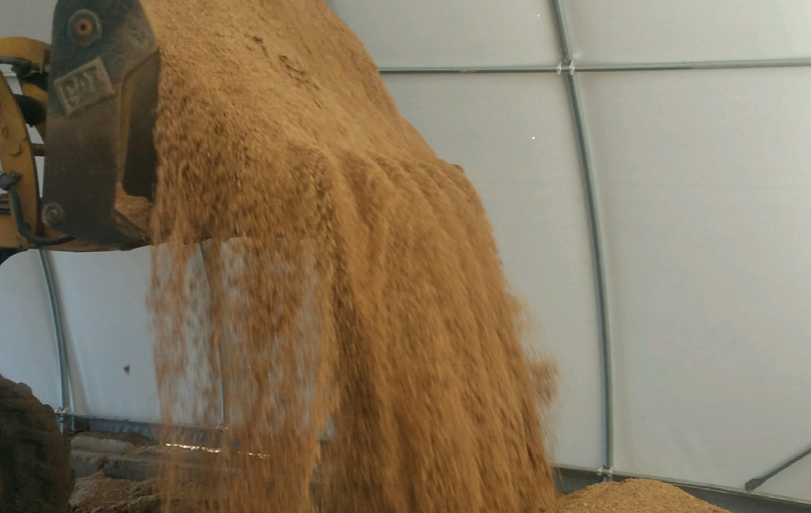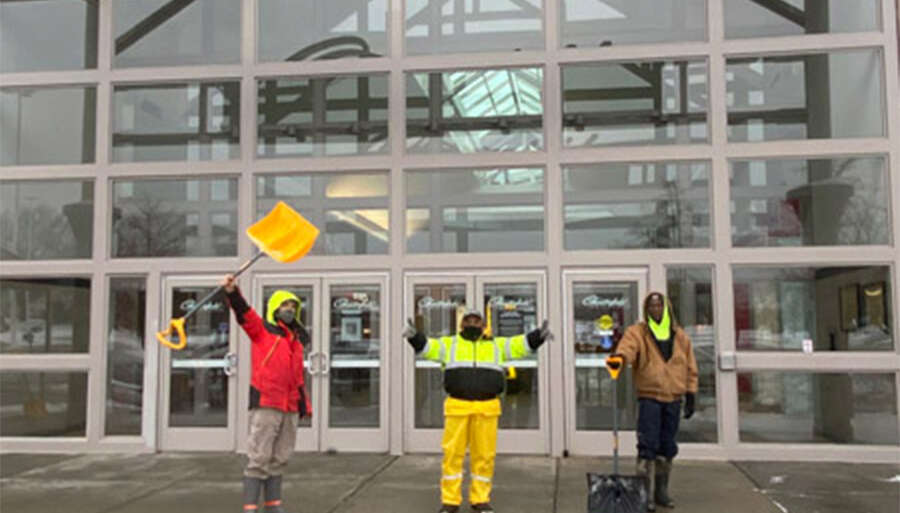Winter Ice Control Basics
BCLS Landscape Services of Central Virginia
for Richmond and Central Virginia Commercial Property Managers
It’s inevitable! Winter, that is. Regardless of whether or not you look forward to this time of year, this is when instincts and traditions take over our lives. We feel the urge to drain, wrap, cover and close up anything that needs to survive the next few months. We assess the condition of our snow equipment and the pile of ice melt bags we have left over from last year.
Traditions are great for family get-togethers and meals that help feed the bear inside us. But the practice of spreading salt for ice melt might be a tradition that needs to be pondered. We all want to keep our traffic areas safe to minimize accidents and falls and salt has been a traditional tool to help minimize the labor. But when it seems like salt isn’t getting the job done, our tendency is to add more. More is good, right?

What if there is a better way? This question has sparked innovation and new methods have been developed in the business of keeping our traffic areas clear of snow and ice. These new products and methods will likely become new traditions very soon. When we have just one option, a decision is easy. That’s tradition. When we have many options, the decisions about what ice melt to use get complicated. In this article, we will summarize common ice melt options available today and the methods for using them that might deviate from tradition.
Keep in mind that the process of melting snow and ice is an exercise in physics and chemistry. In a laboratory we can control variables and determine a temperature when a product ceases to melt ice. This is how phase change melting points are determined. However, in real world applications, many variables will alter the laboratory determined temperature. Moisture level, sunlight, air temp and surface temp are the main variables that affect melting temps. If we include these variables in our evaluation, we come up with an effective temperature. Effective temperature is simply a relative temperature determined through practical use of the product. We’ll use effective temperature to compare ice melt materials.
Dry Salt (NaCl) – Effective Temperature = 10-15 degrees Fahrenheit
Traditional salt is relatively inexpensive but it has a limited effective temperature. It is very corrosive and even within the category of ‘salt’ there are differences. Mined salt is taken from deposits left years ago during the formation of earth.  It often contains other minerals and possibly inert materials that don’t help melt snow and ice. Solar salt is harvested from lake beds and other areas where salt water has been evaporated. Solar salt tends to be more pure NaCl and is more consistent in its effective melting temperature. Here’s a chemistry reminder, dry salt doesn’t melt anything. Only when salt goes into solution does it start to melt surrounding snow or ice. In order to get the process started, many salt products are ‘pre-wetted’ with a de-icing liquid. This method will speed up the melting process by about 20 minutes and usually lowers the effective temperature by 5-100F. Automatic pre-wetting systems are common on DOT trucks that apply dry salt and becoming more common in the commercial snow market.
It often contains other minerals and possibly inert materials that don’t help melt snow and ice. Solar salt is harvested from lake beds and other areas where salt water has been evaporated. Solar salt tends to be more pure NaCl and is more consistent in its effective melting temperature. Here’s a chemistry reminder, dry salt doesn’t melt anything. Only when salt goes into solution does it start to melt surrounding snow or ice. In order to get the process started, many salt products are ‘pre-wetted’ with a de-icing liquid. This method will speed up the melting process by about 20 minutes and usually lowers the effective temperature by 5-100F. Automatic pre-wetting systems are common on DOT trucks that apply dry salt and becoming more common in the commercial snow market.
Dry Calcium Chloride (CaCl2) – Effective temperature = -15F Degrees Fahrenheit
The effective temperature of dry calcium chloride is much lower than traditional salt which makes it a better choice for the colder periods of winter. The cost of calcium chloride is higher than salt but theoretically lower amounts can be used. Being a dry product, the rules about being effectiveness when dissolved in a liquid state apply to calcium chloride also.
Liquid Calcium Chloride (CaCl2) – Effective temperature = -20F Degrees Fahrenheit
Liquid Magnesium Chloride (MgCl2) – Effective temperature = -10 Degrees Fahrenheit
Liquid chlorides are the most common liquids that are used to pre-wet salt as described above. They are also emerging as effective liquid products that can be directly applied to surfaces. They can both prevent snow and ice adhesion to pavement, and melt existing snow and ice. Liquid chlorides are corrosive and more expensive than salt on a volume basis, but their effective temperatures are substantially lower than salt. This means that small amounts of liquid chloride products can be used to achieve good results.  Liquid chlorides are hygroscopic which means that they ‘collect’ moisture. Their molecules seek out water and bind with H2O molecules. The result is a liquid solution on the surface with a much lower freezing point. The benefit is that snow or ice won’t adhere to pavement. It creates a non-stick surface much like a coated frying pan.
Liquid chlorides are hygroscopic which means that they ‘collect’ moisture. Their molecules seek out water and bind with H2O molecules. The result is a liquid solution on the surface with a much lower freezing point. The benefit is that snow or ice won’t adhere to pavement. It creates a non-stick surface much like a coated frying pan.
This is where a change in method comes in. Instead of plowing and spreading dry salt afterward to melt remaining snow, liquid chlorides can be applied before the snow fall. After plowing, the liquid chloride remains in the pavement and an application of salt will usually be unnecessary.
Let’s use two sidewalks as a theoretical example of how liquid chlorides work. We’ll apply the liquid to one of the sidewalks about 6-8 hours before a 6” snowfall. The first thing we’ll notice is that there is 6” of snow on the untreated sidewalk and 5” on the treated sidewalk. The liquid chlorides will initially consume about 1” of the snowfall. Then let’s have heavy traffic on both sidewalks for a couple of hours. After the traffic we’ll get around to plowing. The untreated sidewalk will be difficult to clear and will undoubtedly have snow and ice bonded to the surface. The treated sidewalk will clear off easily and any remaining snow will be dissolved by residual chloride. If we spread dry salt on the untreated sidewalk, we may not get it cleared off for days depending on sunlight, air temp, etc.
Pre-applying the liquid chloride bought us time so that we didn’t need to plow immediately after the snowfall or before the traffic to prevent adhesion to the pavement.
Acetates (KAc) –Effective Temperature = -20 Degrees Fahrenheit
Acetates are a non-chloride type of liquid that have low effective temperatures and are non-corrosive. They are approved by the FAA for airport runway de-icing and are commonly used on automated bridge de-icing systems. The cost of acetate liquids is substantially higher than chloride liquids because they cost more to produce. The methods for using acetates are the same as for liquid chlorides.
Agricultural by-products
We often hear about agricultural by-products being used for de-icing and they are a popular topic because there is very little cost for the materials. Examples are byproducts of sugar beet processing and whey from cheese making. They don’t have significant effective temperature benefits on their own and if applied directly they can have undesirable traits such as slipperiness or smell. They do provide some benefit to blends. For instance, adding sugar beet molasses in a salt brine blend can reduce the corrosive activity of the salt substantially.
Blends
 Blends are a good way to balance the effective temperature of an ice melt product and cost. DOT’s, counties and municipalities will often create liquid salt brines and add liquid chlorides to customize a liquid for their area. Dry and liquid chloride blends are usually created by wholesalers and are sold under brand names. Blends can complicate the buying decision. Blends often have lower effective temperatures than their individual main ingredients due to chemical interactions within the blend. But if you pay attention to the main ingredients and knowing their effective temperatures you can usually make a reasonable choice.
Blends are a good way to balance the effective temperature of an ice melt product and cost. DOT’s, counties and municipalities will often create liquid salt brines and add liquid chlorides to customize a liquid for their area. Dry and liquid chloride blends are usually created by wholesalers and are sold under brand names. Blends can complicate the buying decision. Blends often have lower effective temperatures than their individual main ingredients due to chemical interactions within the blend. But if you pay attention to the main ingredients and knowing their effective temperatures you can usually make a reasonable choice.
Sand
Sand is a traditional tool and it is useful when temperatures are below the effective temperature of all the fore mentioned products. It is good for temporary traction on the surface of ice only. Sand needs to have some salt mixed in with it to prevent it from freezing solid. Before using sand, consider the fact that someone will need to clean it up in the spring and sand is very hard on interior floors when tracked into buildings.
One more thing to consider when choosing an ice melt product is the impact on the surrounding environment. The MPCA has reported an increase in salinity levels of roadside soils and watershed areas around roads treated with salt during the winter. MNDOT aims to address this by adding liquid blends and pre-treatments to its strategy for minimizing dry salt use. A lot of dry salt gets bladed off directly onto surrounding turf. Liquid de-icing products don’t get bladed off. Increased soil salinity can also be an issue for turf and ornamental areas adjacent to sidewalks and parking lots. It is often necessary to replace soils with high salinity before resuming turf growth. Knowing this, the ‘more is good’ argument doesn’t seem so smart.
In closing, it’s important for our snow and ice control contractor to select the right materials to achieve the right results. In order for this to happen you must make sure that your contractor is educated and knowledgeable enough to guide you on what is best for your site conditions and needs.

We offer comprehensive snow and ice removal services
for commercial properties throughout all of Central Virginia
Interested in learning more about our Commercial Snow and Ice Removal Services? Request a consultation right now…
Contact us at (804) 752-0052




